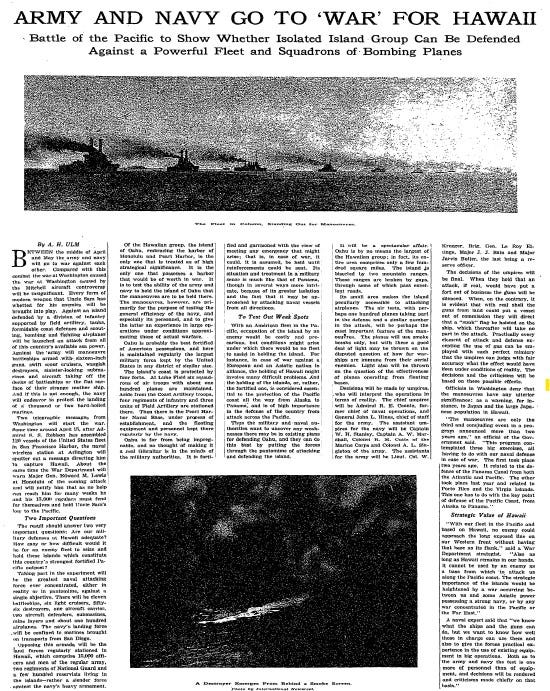Army and Navy Go to 'War' for Hawaii
A full 16 years before Pearl Harbor, a 1925 New York Times Magazine article described an upcoming U.S. military training exercise to test Hawaii's defenses against "squadrons of bombing planes."
As journalist A.H. Ulm wrote:
Are our military defenses at Hawaii adequate? How easy or how difficult would it be for an enemy fleet to seize and hold these islands which constitute this country's strongest fortified Pacific outpost?
The ultimate answers: "no" and "easy."
The exercises, conducted several weeks after the article's publication, proved a gigantic failure. U.S. military members roleplaying as a foreign adversary were able to successfully land ships on Hawaii's coast, undetected by Army planes, then advance a good way into the interior of Oahu on foot before the exercise was called off.
In eerie foreshadowing of actual events, the 1925 article actually referenced both Pearl Harbor and Japan.
Pearl Harbor:
Of the Hawaiian group, the island of Oahu, embracing the harbor of Honolulu and Pearl Harbor, is the only one that is treated as of high strategical [sic] significance. It is the only one that possesses a harbor that would be of worth in war.
Japan:
Officials in Washington deny that the [maneuvers] have any ulterior significance; as a warning, for instance, to Japan and the large Japanese population in Hawaii.
So even after the 1925 exercise's wake-up call, why wasn't the U.S. military better prepared for the actual Pearl Harbor attack in 1941? Part of it may be due to the unanticipated nature of the strike: the 1925 exercise largely prepared against an invasion by ship and by foot, rather than the kamikaze mission by air.
2,390 Americans died at Pearl Harbor on December 7, 1941 which President Franklin Delano Roosevelt termed "a date which will live in infamy." As of December 2024, only 16 survivors of the attack were still alive.
Army and Navy Go to 'War' for Hawaii: Battle of the Pacific to Show Whether Isolated Island Group Can Be Defended Against a Powerful Fleet and Squadrons of Bombing Planes
Published: Sunday, March 29, 1925


